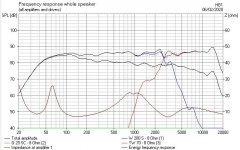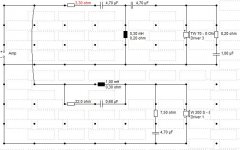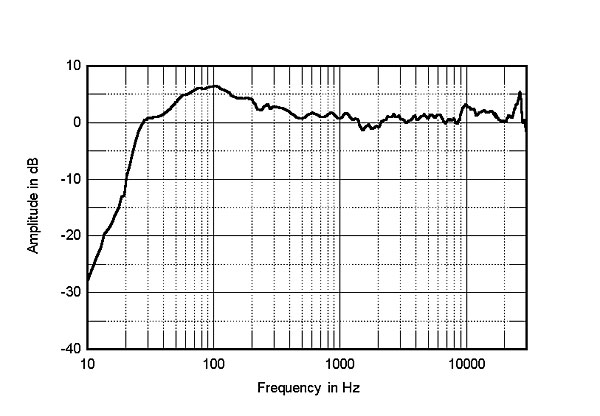The so called BBC-dip/Gundry dip could be motivated by the ears sensitivity to certain frequencies (see equal loudness contour) and that a horisontal and straight frequency curve can cause listening fatigue, especially with poorly recorded music.
Equal-loudness contour - Wikipedia
I wonder how they came up with these curves, with headphones or a center speaker or what?
The 'dip' effect is real 
I just switched the input of my MiniDSP crossover from analog (fed by my tube buffered DAC) to digital (fed optical from the computer at 24/96KHz). My initial reaction was that the image was reduced and the vocals were a touch shouty. I did not like the digital input at all. I initially thought the DAC was mellowing out and widening the soundstage. Then I realized I had a -3dB at 2KHz 'dip' dialed into the analog side of the crossover that was missing from the digital input. Once I matched them, all was well. I believe I now prefer the direct digital input to to the crossover .. elimination the extra A/D - D/A conversion ... even though I love the sound of the DAC when going into an analog setup.
I just switched the input of my MiniDSP crossover from analog (fed by my tube buffered DAC) to digital (fed optical from the computer at 24/96KHz). My initial reaction was that the image was reduced and the vocals were a touch shouty. I did not like the digital input at all. I initially thought the DAC was mellowing out and widening the soundstage. Then I realized I had a -3dB at 2KHz 'dip' dialed into the analog side of the crossover that was missing from the digital input. Once I matched them, all was well. I believe I now prefer the direct digital input to to the crossover .. elimination the extra A/D - D/A conversion ... even though I love the sound of the DAC when going into an analog setup.
But Celef, we are not driving sound at the ear from anywhere other than the front on axis, the differing ear response to sound from different directions applies to both real sound and that from a speaker.
OK, I understand that many think that using a dip is valid, even if only on subjective grounds, it is the rational which I find troublesome.
(BTW the BBC had a presence control on the 'D' type desks centred I believe at about 3.16k IIRC).
Flat on axis should not give a prevalence to the presence range because as we all know we want flatness in order to accurately convey to the listener the energy at every point in the spectrum that was in the source; that is why we seek flat amplifiers.
If it is argued that the ear is less sensitive to the presence range from ambient or reflected sources, these often resulting from a speaker's off axis response, then the total overall quantity of presence energy will be lower for presence frequencies than at others, where the ear has a greater sensitivity to non direct energy.
I can accept that the BBC designed in the dip for reasons of the limitations of both drivers in a two way, those of break-up from the mid/woofer, and the inability of the tweeter to go low because of limited Xmax or its resonance not being far enough out of its operating band. This is a different problem, and IMO a bodge solution, but driver limitations at that time may well have imposed it as a solution, drivers having improved considerably since then.
OK, I understand that many think that using a dip is valid, even if only on subjective grounds, it is the rational which I find troublesome.
(BTW the BBC had a presence control on the 'D' type desks centred I believe at about 3.16k IIRC).
Flat on axis should not give a prevalence to the presence range because as we all know we want flatness in order to accurately convey to the listener the energy at every point in the spectrum that was in the source; that is why we seek flat amplifiers.
If it is argued that the ear is less sensitive to the presence range from ambient or reflected sources, these often resulting from a speaker's off axis response, then the total overall quantity of presence energy will be lower for presence frequencies than at others, where the ear has a greater sensitivity to non direct energy.
I can accept that the BBC designed in the dip for reasons of the limitations of both drivers in a two way, those of break-up from the mid/woofer, and the inability of the tweeter to go low because of limited Xmax or its resonance not being far enough out of its operating band. This is a different problem, and IMO a bodge solution, but driver limitations at that time may well have imposed it as a solution, drivers having improved considerably since then.
The mix itself is supposed to be easy on the human hearing as judged in the production chain by all the professionals involved. Their gear are also supposed to be least flawed so any peculiarities in the product shall be intentionally creative, not erroneous due to significant technical limitations. The replay chain is supposed to not modify the recorded product. If flexible for the end user to can intervene beyond hands off mode, still capable for enough neutrality in the first place. But that's an optimum approach.
The 'BBC dip' was used by the BBC in very specific cases, but came out of Harwood et al's research on speaker design, acoustical scaling and recording practice. I can't quote the whole article since it's too large, but if you want the origin or reasoning behind it, from the horse's mouth, this is what they were doing and why:
The next point to be discussed is the question of optimum axial frequency response. This question is not concerned with how wide a frequency range should be covered, but what shape the response curve should be. First of all the underlying assumption must be clearly stated. This is that both the microphone and all associated amplifiers have a uniform, frequency response. The usual conclusion is that the loudspeaker should also have a uniform axial frequency response but this is precisely what is being challenged. Not even in stereo reproduction are the sound wave- fronts produced in a listening room similar to those heard in the studio or concert hall and it therefore seems clear that if by "bending" the axial response curve of the loudspeaker a more realistic psychological impression is obtained, then this is entirely justified. Thus, for example, if a uniform output is maintained at all frequencies an orchestra sounds extremely close.
This condition is quite unnatural and a much better sense of perspective is obtained if a slight dip in the 1 to 3kHz region is applied. About 2dB is sufficient to provide the more distant perspective without destroying the sound quality. It may well be that as techniques progress other such tricks will follow. All that is intended at this stage is to get away from the rigid idea that a uniform axial response is necessarily the best.
Harwood, H. D., BBC Research Department, 'Some Factors in Loudspeaker Quality' Wireless World May 1976 p.50
The point here is that Harwood was not stating 'everybody should do this'. Good researcher / engineer / partial academic that he was, he was presenting this (amongst a lot of other data) in an attempt to get people to think about context and objectives, rather than blindly following a specific mantra (i.e. 'flat axial response is always "best" in all circumstances'). Now, you can agree with this specific implementation or not: it doesn't matter. He also expected (and no doubt hoped to provoke) some contemporary debate, but in fairness, we can state that this broad point is supported by a large body of research confirming that a non-flat response (whatever the specific EQ might be) is generally preferred in 'real world' conditions. The more specific reason for this particular EQ sometimes being applied was also perfectly sound within the context of the underlying, clearly stated assumptions / conditions.
So there you have it. That's where it came from, and that's why it was sometimes (note the caveat) done at the time within the context of the author and his immediate surroundings. Whether others subsequently applied it for the same purposes is quite another matter.
The next point to be discussed is the question of optimum axial frequency response. This question is not concerned with how wide a frequency range should be covered, but what shape the response curve should be. First of all the underlying assumption must be clearly stated. This is that both the microphone and all associated amplifiers have a uniform, frequency response. The usual conclusion is that the loudspeaker should also have a uniform axial frequency response but this is precisely what is being challenged. Not even in stereo reproduction are the sound wave- fronts produced in a listening room similar to those heard in the studio or concert hall and it therefore seems clear that if by "bending" the axial response curve of the loudspeaker a more realistic psychological impression is obtained, then this is entirely justified. Thus, for example, if a uniform output is maintained at all frequencies an orchestra sounds extremely close.
This condition is quite unnatural and a much better sense of perspective is obtained if a slight dip in the 1 to 3kHz region is applied. About 2dB is sufficient to provide the more distant perspective without destroying the sound quality. It may well be that as techniques progress other such tricks will follow. All that is intended at this stage is to get away from the rigid idea that a uniform axial response is necessarily the best.
Harwood, H. D., BBC Research Department, 'Some Factors in Loudspeaker Quality' Wireless World May 1976 p.50
The point here is that Harwood was not stating 'everybody should do this'. Good researcher / engineer / partial academic that he was, he was presenting this (amongst a lot of other data) in an attempt to get people to think about context and objectives, rather than blindly following a specific mantra (i.e. 'flat axial response is always "best" in all circumstances'). Now, you can agree with this specific implementation or not: it doesn't matter. He also expected (and no doubt hoped to provoke) some contemporary debate, but in fairness, we can state that this broad point is supported by a large body of research confirming that a non-flat response (whatever the specific EQ might be) is generally preferred in 'real world' conditions. The more specific reason for this particular EQ sometimes being applied was also perfectly sound within the context of the underlying, clearly stated assumptions / conditions.
So there you have it. That's where it came from, and that's why it was sometimes (note the caveat) done at the time within the context of the author and his immediate surroundings. Whether others subsequently applied it for the same purposes is quite another matter.
Last edited:
Thank you, and I accept that, but it clearly falls into the 'subjectivist', ("is generally preferred"), category because it lacks any proof by objectivist, (measured and mathematical), means, which is OK if recognised as that.
I'm thinking of buying a graphic equaliser in order to experiment.
I'm thinking of buying a graphic equaliser in order to experiment.
The 'BBC dip' was used by the BBC in very specific cases, but came out of Harwood et al's research on speaker design, acoustical scaling and recording practice.
Would he be led to the same conclusion about the usefulness of a presence range dip if the monitoring speakers of his time had a uniform power response, will remain an interesting theoretical question.
...but it clearly falls into the 'subjectivist', ("is generally preferred"), category because it lacks any proof by objectivist, (measured and mathematical), means, which is OK if recognised as that.
I would argue otherwise. There are clearly reported differences in hearing sensitivity in this frequency band for cases using direct (pseudo-anechoic) and diffuse (reverberant, free field) measures. Not by chance, this is also the most prominent band where the stereo phantom image collapses (for conventional two channel reproduction). Reproducing the lateral information via loudspeakers in front of the listener therefore produces some audible artefacts that will be dependent on at least the recording venue, the microphone arrangement, the loudspeaker directivity and the listening environment. I would imagine collating all the information and presenting a single objective measure to describe the effect would not therefore be a trivial exercise, but that current lack of understanding does not mean the BBC dip should be labelled as a purely subjective phenomenon.
All fascinating stuff!
If you want to pin me down, all the "BBC Dip" fudge is about matching a huge polycone 12" bass with an Audax 1.5" tweeter.
That's what the BBC did in the 1970's. This topic has continued onward into stuff like the flat FR Studio-101
Flat monitoring a recording for playback accuracy is a different subject from pure musical listening. One is based on accuracy, the other is based on enjoyment.
This Joachim Gerhard 8" plus 1" two way is about his best attempt at a simple BBC-style monitor speaker:
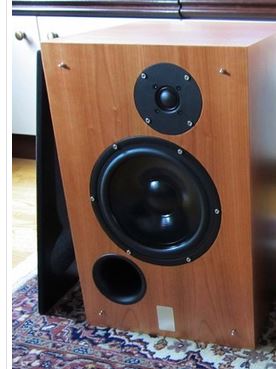
But everybody knows a three-way like Troels Gravesen's Classic three way will work better:
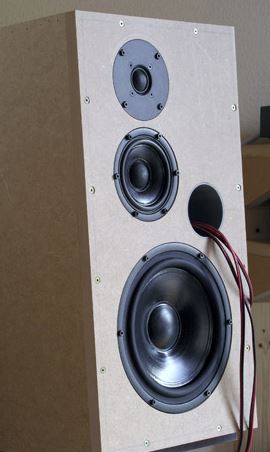
Interestingly, there is a sort of overlap between two-way speakers that might fix the power hole in a two-way. It's called BW3. Since I am in Linux right now, I am not sure I can upload these images. But BW3 works in either polarity and fixes the power hole.
If you want to pin me down, all the "BBC Dip" fudge is about matching a huge polycone 12" bass with an Audax 1.5" tweeter.
That's what the BBC did in the 1970's. This topic has continued onward into stuff like the flat FR Studio-101
Flat monitoring a recording for playback accuracy is a different subject from pure musical listening. One is based on accuracy, the other is based on enjoyment.
This Joachim Gerhard 8" plus 1" two way is about his best attempt at a simple BBC-style monitor speaker:
But everybody knows a three-way like Troels Gravesen's Classic three way will work better:
Interestingly, there is a sort of overlap between two-way speakers that might fix the power hole in a two-way. It's called BW3. Since I am in Linux right now, I am not sure I can upload these images. But BW3 works in either polarity and fixes the power hole.
Attachments
If you want to pin me down, all the "BBC Dip" fudge is about matching a huge polycone 12" bass with an Audax 1.5" tweeter.
I would politely suggest that pinning down the thoughts of Harwood (post #68) is all this thread was missing.
i can not see how a 3khz dip can fix anything, it only seems to make things even worse. so how do we get a better phantom center image and a correct tonal balance from it, putting stereo speakers closer together? make sure that we get more and accurate reflections from the wall between the speakers? or use a third filler center speaker for freq above 1khz?
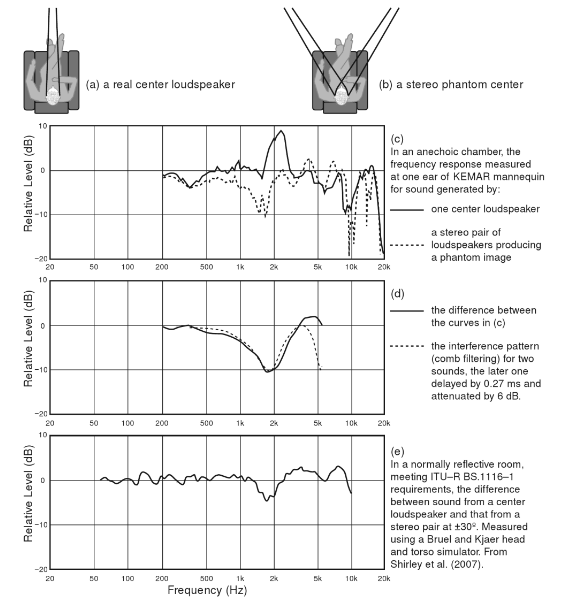
i can not see how a 3khz dip can fix anything, it only seems to make things even worse. so how do we get a better phantom center image and a correct tonal balance from it, putting stereo speakers closer together? make sure that we get more and accurate reflections from the wall between the speakers? or use a third filler center speaker for freq above 1khz?

If your post alludes to my comments, then I never implied it fixes anything. It merely compensates for errors in frequency balance due to the space in between the ears affording different thresholds of audibility for sounds emanating from different directions. In a stereo recording that effect can lead to a perceivable change that can be compensated somewhat rather than corrected.
As for the stereo phantom image, it is a different subject and I have commented previously in the thread from where your image is taken. Moving the speakers together moves from stereo to "transaural" where the BBC dip may no longer be applicable. Non-frequency selective reflections are always preferable, but three speaker stereo obviates the need for as many as with conventional two loudspeaker stereo. I would suggest that the frequency balance error will scarcely be altered in such a case, however, as it is largely a function of the stereo encoding (all other things being as equal as they can be).
Good to have the X flow of thoughts.
I go strongly with system7's thoughts on the reasons, as previously stated.
Consider this; no mixing or 'doctoring', a pure Blumlein pair of exceedingly high quality mics., making a recording of a pure natural sound, or instruments, and the replay being with flat speakers. The only consideration then will,be the room acoustics in each case.
(Alan Shaw, with Derek Hughes, did a recording in the BBC anechoic chamber just before it was demolished, and with the best mic. in the world, and posted it on his site. I have a burnt CD of it, it is clean, but it sounds a bit 'chesty'.)
Now what will be the argument for the dip?
One of the real giveaways with stereo, and this may have been a factor in the dip, is that sibilants from eg. a central image, suddenly come at us from both extremes, and shatter the illusion. (her teeth and lips are not t'ing and s'ing from 8ft apart.
I go strongly with system7's thoughts on the reasons, as previously stated.
Consider this; no mixing or 'doctoring', a pure Blumlein pair of exceedingly high quality mics., making a recording of a pure natural sound, or instruments, and the replay being with flat speakers. The only consideration then will,be the room acoustics in each case.
(Alan Shaw, with Derek Hughes, did a recording in the BBC anechoic chamber just before it was demolished, and with the best mic. in the world, and posted it on his site. I have a burnt CD of it, it is clean, but it sounds a bit 'chesty'.)
Now what will be the argument for the dip?
One of the real giveaways with stereo, and this may have been a factor in the dip, is that sibilants from eg. a central image, suddenly come at us from both extremes, and shatter the illusion. (her teeth and lips are not t'ing and s'ing from 8ft apart.
I find the B&W DM 4 an interesting speaker.It is very much of the 1970s BBC type.It uses a bextrene coned mid/woofer in combination with the Celestion HF1300 tweeter and Coles super tweeter with third order crossovers.So very similar to the Spendor BC1 and Rogers Export Monitor.
It has an almost ruler flat frequency response and does sound brighter and more forward .
Google Image Result for https://randomthoughtsintowords.files.wordpress.com/2016/01/dm4-freq-curve.png
It has an almost ruler flat frequency response and does sound brighter and more forward .
Google Image Result for https://randomthoughtsintowords.files.wordpress.com/2016/01/dm4-freq-curve.png
I sound like the Officer at the Royal Marines Associate Band Concert 
But really, the old guys do it well.
About the Band - The Royal Marines Association Concert Band
I was previldged to play host to Portsmouth's finest female swing band: The Three Belles:
YouTube
These 3 young Portsmouth University Students just knocked me out. I had to tell them that I also loved the 1940's Victory-Roll hairstyles.
My Momma used to do this stuff very well.
But really, the old guys do it well.
About the Band - The Royal Marines Association Concert Band
I was previldged to play host to Portsmouth's finest female swing band: The Three Belles:
YouTube
These 3 young Portsmouth University Students just knocked me out. I had to tell them that I also loved the 1940's Victory-Roll hairstyles.
My Momma used to do this stuff very well.
- Status
- This old topic is closed. If you want to reopen this topic, contact a moderator using the "Report Post" button.
- Home
- Loudspeakers
- Multi-Way
- BBC Dip
